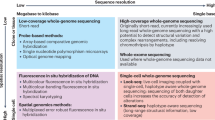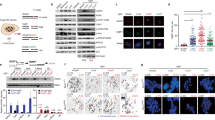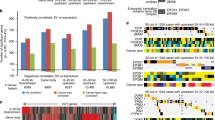Abstract
The human IGF2 gene belongs to a group of imprinted genes clustered on the short arm of chromosome 11, band p15.5. It contains 9 exons and spans over 30 kb. IGF2 mRNA overexpression has been reported in human tumours and in some inherited growth disorders. It was recently demonstrated that IGF2 mRNA overexpression contributes to tumour progression and that loss of parental imprinting as well as altered transcription factors are contributing to this overexpression. We have reported structural alterations in the 3′ region of the IGF2 gene in two colorectal tumours that overexpressed the IGF2 transcript by 200- and 800-fold. We cloned by the vectorette-PCR strategy, genomic DNA fragments containing the breakpoints from these tumours. The sequencing of these fragments positioned the breakpoint 2 kb downstream the IGF2 gene in one tumour, and in exon 9 in the second. Both breakpoints occurred in regions containing repetitive elements: a TGGA repeat we have identified downstream the gene, and the (CA)n repetition in exon 9. We hypothesize that a negative regulatory element, located downstream the IGF2 gene, has been deleted following these structural alterations and leads to IGF2 gene overexpression.
This is a preview of subscription content, access via your institution
Access options
Subscribe to this journal
Receive 50 print issues and online access
$259.00 per year
only $5.18 per issue
Buy this article
- Purchase on Springer Link
- Instant access to full article PDF
Prices may be subject to local taxes which are calculated during checkout




Similar content being viewed by others
References
Arnold C and Hodgson IJ. . 1991 PCR Methods Appl. 1: 39–42.
Baffa R, Negrini M, Mandes B, Rugge M, Ranzani GN, Hirohashi S and Croce CM. . 1996 Cancer Res. 56: 268–272.
Besnard-Guérin C, Newsham I, Winqvist R and Cavenee WK. . 1996 Hum. Genet. 97: 163–170.
Christofori G, Naik P and Hanahan D. . 1994 Nature 369: 414–418.
Daughaday WH, Emanuele MA, Brooks MH, Barbato AL, Kapadia M and Rotwein P. . 1988 N. Engl. J. Med. 319: 1434–1440.
Daughaday WH and Rotwein P. . 1989 Endocr. Rev. 10: 68–91.
de Moor CH, Jansen M, Sussenbach JS and Van den Brande JL. . 1994 Eur. J. Biochem. 222: 1017–1024.
Ellsworth DL, Hewett-Emmett D and Li WH. . 1994 Mol. Biol. Evol. 11: 875–885.
Fidler AE, Maw MA, Eccles MR and Reeve AE. . 1992 Lancet 339: 243.
Giannoukalis N, Deal C, Paquette J, Goodyear CG and Polychronakos C. . 1993 Nature Genet. 4: 98–101.
Gicquel C, Bertagna X and Le Bouc Y. . 1995 Eur. J. Endocrinol. 133: 133–144.
Humbel RE. . 1990 Eur. J. Biochem. 190: 445–462.
Irminger JC, Schoenle EJ, Briner J and Humbel RE. . 1989 Eur. J. Pediatr. 148: 620–623.
Ishida S, Noda M, Kuzuya N, Kubo F, Yamada S, Yamanka T, Isozaki O, Hizuka N and Kanazawa Y. . 1995 Internal Med. 34: 1201–1206.
Jones JI and Clemmons DR. . 1995 Endocrine Rev. 16: 3–34.
Karnik P, Chen P, Paris M, Yeger H and Williams BRG. . 1998 Oncogene 17: 237–240.
Lambert S, Vivario J, Boniver J and Gol-Winkler R. . 1990 Int. J. Cancer 46: 405–410.
Mannens M, Hoovers JMN, Redeker E, Verjaal M, Feinberg AP, Little P, Boavida M, Coad N, Steenman M, Bliek J, Niikawa N, Tonoki H, Nakamura Y, de Boer EG, Slater RM, John R, Cowell JK, Junien C, Henry I, Tommerup N, Weksberg R, Pueschel SM, Leschot NJ and Westerveld A. . 1994 Eur. J. Hum. Genet. 2: 3–23.
Minniti CP and Helman LJ. . 1994 Current Directions in Growth Factors Research. Leroith D and Raizada MK. (eds).. Plenum Press: New York pp. 327–345.
Rainier S, Johnn LA, Dobry CJ, Ping AJ, Grundy PE and Feinberg AP. . 1993 Nature 362: 747–749.
Reeve AE, Eccles MR, Wilkins RJ, Bell GI and Millow LJ. . 1985 Nature 317: 258–260.
Rogler CE, Yang D, Rossetti L, Donohe J, Alt E, Chang CJ, Rosenfeld R, Neely K and Hintz R. . 1994 J. Biol. Chem. 269: 13779–13784.
Schneid H, Seurin D, Noguiez P and Le Bouc Y. . 1992 Growth Regul. 2: 45–54.
Smit AFA. . 1996 Curr. Opin. Genet. Devel. 6: 743–749.
Sun F-L, Dean WL, Kelsey G, Allen ND and Reik W. . 1997 Nature 389: 809–815.
Sussenbach JS, Rodenburg RJT, Scheper W and Holthuizen P. . 1994 Current Directions in Insulin-like Growth Factor Research. Leroith D and Raizada MK. (eds).. New York pp. 63–71.
Toretsky JA and Helman LJ. . 1996 J. Endocrinol. 149: 367–372.
Winqvist R, Hampton GM, Mannermaa A, Blanco G, Alavaikko M, Kiviniemi H, Taskinen PJ, Evans GA, Wright FA, Newsham I and Cavenee WK. . 1995 Cancer Res. 55: 2660–2664.
Acknowledgements
This work was supported by a grant form the Belgian ‘Fonds National pour la Recherche Scientifique (FNRS.)’, ‘Association sportive contre le cancer’, ‘Association contre le Cancer’, ‘Centre Anticancéreux près l'Université de Liège’ and ‘Fondation Léon Fredericq’. R Winkler is ‘Chercheur Qualifié’ of the FNRS. D Hodzic and M Grooteclaes are recipients of ‘Télévie’ grants from the FNRS.
Author information
Authors and Affiliations
Rights and permissions
About this article
Cite this article
Hodzic, D., Frey, B., Marechal, D. et al. Cloning of breakpoints in and downstream the IGF2 gene that are associated with overexpression of IGF2 transcripts in colorectal tumours. Oncogene 18, 4710–4717 (1999). https://doi.org/10.1038/sj.onc.1202877
Received:
Revised:
Accepted:
Published:
Issue Date:
DOI: https://doi.org/10.1038/sj.onc.1202877
Keywords
This article is cited by
-
Expression and efficient purification of tag-cleaved active recombinant human insulin-like growth factor-II from Escherichia coli
Biotechnology and Bioprocess Engineering (2015)



